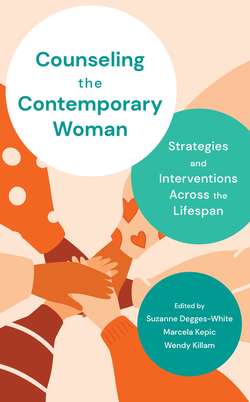Читать книгу Counseling the Contemporary Woman - Suzanne Degges-White - Страница 57
Identity Development
ОглавлениеIdentity formation is a central task for adolescents to achieve. In fact, Erikson (1968) termed the central conflict during this period as “identity versus identity confusion.” This period is shaped by an individual’s ability to successfully overcome challenges that relate to solidification of a young woman’s identity. As adolescents seek to define their identities, they may face challenges in terms of acceptance by their families, peers, or significant others as they “try on” behaviors they feel congruent to the identity they are trying to portray. For instance, if a young woman is seeking to be accepted by a particular social clique, she may emulate behaviors and attitudes endemic to these peers. If these behaviors are not congruent with how the young woman sees herself or how close friends see her, and her efforts do not win her acceptance into the desired group, she may drop these behaviors from her repertoire.
Using Erikson’s theory as a framework, James Marcia and his associates (1980) identitfied and labeled four discrete statuses that may be achieved during the identity formation process. These are moratorium, diffusion, foreclosure, and achievement. Identity moratorium occurs when the adolescent is exploring various identities to find the one that is most congruent with her true self, but is not yet committed to a final choice. Diffusion is marked by a lack of awareness that identity options are available for exploration. Foreclosure represents a status in which a young woman has not faced any type of identity crisis or has felt the need to explore identities beyond the one she currently possesses, which may likely conform to the expectations of others. Identity achievement is the result of having explored possible identities and having chosen the one that best fits how the young woman sees herself. Despite the fact that identity formation begins during adolescent years, as young people make visible strides in developing who they will be as adults, the formation of identity does not end in adolescence. Through ongoing growth and development, self-representation might change several times over the lifespan, and life stories may be revised by life circumstances.
Even though Erikson’s developmental theory has been widely accepted, it faces some criticism that it is primarily centered on emphasizing separateness or autonomy, a significant feature of masculinity, and fails to emphasize connectedness as a healthy personality development, especially for women (Gilligan, 1982). Regardless of gender, having a sense of social belonging plays a key role in healthy identity development (Medina, Rivas-Drake, Jagers, & Rowley, 2019). Research suggests that relational issues are much more important for women’s development than they are for men; further, adolescent girls tend to have closer friendships than boys, which leaves them more vulnerable to distress when friendships end (Collins & Steinberg, 2006). In addition, females tend to value interpersonal, communal aspects of their identities more highly than males. As for whether identity development pathways are different for women and men, the question remains complex and lacks any definite answer at this point. Research suggests that the genders show more similarities than differences in identity development; however, the content of their identity choices might differ (Waterman, 1993; Collins & Steinberg, 2006).
